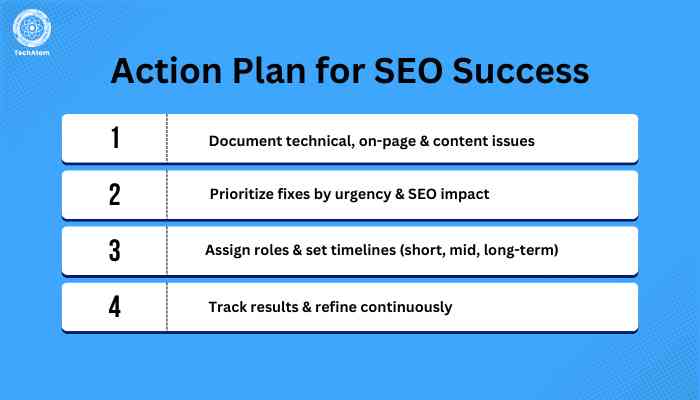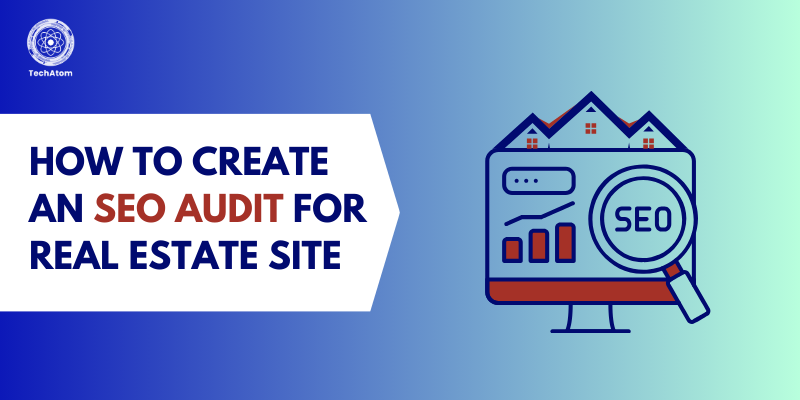Search engines are a big part of how real estate businesses find buyers and sellers today. When someone looks online for a home or property, real estate websites appear in the results.
If your site ranks at the top, it will gain more organic visitors. This means more messages, more interest, and more chances to make a sale. Being easy to find on search engines also helps people trust your business. If you're not showing up there, you're missing out on people who are ready to buy or sell.
User-friendly content, fast-loading pages, mobile friendliness, and accurate local listings all help to increase a real estate website's visibility. An SEO-optimized website promotes trust, builds engagement, and keeps visitors interested in the services provided.
Search engines continually upgrade their ranking algorithms, and competitors adapt their ways to improve their rankings. A previously successful website may lose visitors if it is not updated regularly.
Regular SEO audits help to detect technology flaws, poor content, and outdated optimization tactics. Fixing these issues improves rankings and user experience, which leads to more engagement and transactions. An audit also offers useful data for improving marketing efforts and keeping the website competitive in online searches.
In this post, we’ll discuss how you can create an SEO audit for your real estate website.
Understanding the Basics of SEO Audits
An SEO audit reviews whether a website is built the right way for search engines to understand and rank it. For real estate professionals, it means looking at key parts of their site to see if it's doing a good job bringing in and keeping the attention of possible buyers or sellers.
Conducting these audits often helps spot problems that could be hurting search rankings. It also gives a chance to fix those issues and make the website easier to find online.
Key components of an SEO audit

1. Technical SEO Checkup
- Site Structure and Navigation: Ensure your website is easy to navigate and browse for users and search engines.
- Mobile Optimization: Smartphones and tablets are used significantly for searching properties. So, your website should be compatible with these devices.
- Page Load Speed: Check and optimize page loading times to reduce bounce rates and enhance user experience.
- Indexing and Crawlability: Search engines should not detect errors while crawling and indexing the website pages.
2. On-Page SEO Analysis
- Content Quality and Relevance: Listings and info should be useful, updated, and fit what your audience wants.
- Keyword Optimization: Use keywords that match what people are searching for.
- Meta Tags and Descriptions: Make sure titles and descriptions match the page content.
- Image Optimization: Ensure titles and descriptions match the page content.
3. Off-Page SEO Evaluation
- Backlink Profile: Use alt text and compress images to keep them sharp and fast to load.
- Local Citations: Keep your business name, address, and phone number the same everywhere online.
- Social Media Presence: Active social media accounts can boost traffic and brand visibility.
4. User Experience (UX) and User Interface (UI) Evaluation
- Navigation and Layout: Make sure the site is easy to use and the info is easy to find.
- Call-to-Action Elements: Check if buttons like “Contact” or “Schedule a Visit” are easy to spot and work well.
- Visual Content: Use clear photos, videos, and tours—these matter a lot in real estate.
Preparing for the SEO Audit
Before starting an SEO audit for a real estate website, set a clear plan and gather the right tools. Good preparation keeps the process organized and effective.
Setting Clear Objectives and Goals:
Start by identifying what you hope to achieve through the audit. Goals may include boosting local visibility, growing organic traffic, generating qualified leads, or spotting weak pages. Clear goals keep the audit focused and measurable.
Consider questions such as:
-
Are property listings coming up in relevant searches?
- Is the website ranking high for target neighborhoods or city names?
- Are people finding the site helpful and engaging?
Outlining clear objectives allows you to prioritize work and track measurable achievements after the audit.
Accurate data is key for a successful SEO audit. Use a mix of free and paid tools to gather the right information. Here are a few tools that you can use:
- Google Analytics - track user behavior, traffic sources, and engagement.
- PageSpeed Insights or GTmetrix - to assess website speed and discover technical issues.
- Mobile-Friendly Test - to see how the website operates on mobile devices.
- Screaming Frog or Sitebulb - for a comprehensive website scan to detect broken links, redirect chains, and metadata issues
- Semrush, Ahrefs, or Moz - to evaluate keyword ranks, backlinks, and competitor performance.
- SurferSEO or Yoast SEO - to assess on-page features and content optimization.
Conducting the SEO Audit

An SEO audit for a real estate website comprises analyzing several factors to optimize performance and visibility in search engine results. This method includes a few critical areas:
1. Technical SEO Assessment
- Evaluating Website Speed and Performance: Page load speed affects user experience and SEO. Use tools like Google PageSpeed Insights to find and fix speed issues.
- Ensure Mobile-Friendliness and Responsive Design: Many users browse on mobile, so your site must be responsive and work well on all screen sizes. Use Google’s Mobile-Friendly Test to check and improve mobile usability.
- Checking Site Architecture and URL Structure: A clear site structure makes it easier for users and search engines to find content. Keep URLs simple, descriptive, and organized in a logical order.
- Identifying and Fixing Crawl Errors: Regularly check for crawl issues in Google Search Console to make sure search engines can access and index your pages. Addressing these issues quickly guarantees that all valuable content is discoverable.
- Assessing SSL Certification and Website Security: Security is a concern for both users and search engines. Implementing SSL certificates (HTTPS) protects user data while also improving search ranks.
2. On-Page SEO Analysis
- Reviewing Content Quality and Relevance: Content that is original, helpful, and tailored to your audience attracts visitors. Keep property listings and blog posts fresh by updating them regularly.
- Analyzing Keyword Usage and Optimization: Conduct a thorough keyword research to find what your target audience intent. Use those keywords naturally in your content, titles, and meta descriptions to boost visibility in search results.
- Examining Meta Titles and Descriptions: Create unique and interesting meta titles and descriptions for each page. These components appear as a preview in search results and can affect click-through rates.
- Checking the Header Tags and Content Hierarchy: Use header tags (H1, H2, and H3) to clearly structure your material. This arrangement improves readability and helps search engines grasp the significance of different sections.
- Assessing Image Optimization and Alt Text Usage: Optimize pictures by reducing file sizes for faster loading and adding descriptive alt text to promote accessibility and SEO.
3. Off-Page SEO Evaluation
- Analyzing Backlink Profiles and Domain Authority: Check the number and quality of backlinks to your website. High-quality backlinks from credible sources can help your website's authority and search rankings.
- Assessing Social Media Integration and Presence: Active participation on social media platforms can increase traffic to your website and indicate relevance to search engines. Make sure your material is shareable and continuously promoted across channels.
- Identifying Local Citations and Directory Listings: Maintain accurate and consistent listings in local directories and real estate platforms to boost local search visibility and trustworthiness.
4. Local SEO Considerations
- Verifying Google My Business Listing Accuracy: To improve your local search visibility, ensure that your Google My Business profile is accurate and up to date, including correct business information, working hours, and images.
- Ensure Consistency of NAP (Name, Address, Phone Number) Information: Consistent NAP information across your website and external listings helps search engines link your company with specific locations, hence improving local SEO results.
- Encourage and Manage Customer Reviews: Positive reviews not only impact future customers but also help local search rankings. Encourage happy customers to comment and respond quickly to reviews to showcase engagement.
By carefully resolving these issues, real estate professionals can improve the performance of their website, increase search engine presence, and attract more potential clients.
Analyzing Competitor SEO Strategies
Understanding how competitors perform in search results can give you insight to enhance your rankings and attract more visitors. A methodical approach can assist in identifying the methods that drive visitors to competing real estate websites.
Identifying the Main Competitors in the Real Estate Market
Competitors may be direct or indirect. Direct competitors compete in the same area, targeting similar audiences with equivalent offerings. Indirect rivals may specialize in larger real estate themes, such as property listings, market analysis, or investment advice.
To Identify the Key Competitors:
- Look for target keywords linked to real estate in your area and observe which websites consistently appear on the first page.
- Use SEO tools like Semrush, Ahrefs, or Moz to compile a list of competitive domains.
- Examine local business directories and Google My Business listings for notable agencies or brokerages.
Comparing Website Performance and Rankings
After identifying competitors, assessing their website performance yields useful information. Metrics for comparison include:
- Domain Authority (DA) or Domain Rating (DR): Measures the strength of a website's backlinks.
- Organic Traffic: Estimates how many visitors arrive via search engines.
- Keyword Rankings: Determines which terms generate visitors to their website.
- Page Load Speed: Faster websites rank higher and offer a better user experience.
- Mobile Optimization: Ensures that pages function properly on smartphones and tablets.
SEO tools can give you the data on these parameters, indicating where a website succeeds or falls behind competitors.
Learning About Competitors' Strengths and Weaknesses
Real estate professionals can improve their SEO tactics by analyzing their competition. Key areas to investigate include:
- Content Quality and Type: Do rivals create thorough neighborhood guides, market studies, or video content? If yes, how detailed and insightful is their coverage?
- Backlink Profile: Which websites link to their pages? Are there any opportunities to obtain comparable links?
- On-page Optimization: Do they employ organized data, optimized pictures, or well-written meta descriptions?
- User Engagement: How do they build sites so that visitors remain engaged? Are they using chatbots, interactive maps, or mortgage calculators?
Adapting successful approaches while resolving weaknesses in a competitor's plan might boost search exposure and attract new customers.
Compiling Findings and Creating an Action Plan

An organized method guarantees that SEO improvements are thoroughly documented, prioritized, and carried out efficiently. Breaking down projects into achievable segments allows you to track progress and achieve measurable results.
After you’ve found the required information, here’s how you can create an action plan to improve your own rankings:
Documenting Issues and Areas for Improvement
After an SEO audit, listing all discovered faults gives a clear picture of what has to be addressed. The categories to document include:
- Technical errors include broken links, slow page loading, and mobile usability concerns.
- On-page SEO flaws include missing meta tags, poorly optimized content, and a lack of internal links.
- Weaknesses in content include low-quality or obsolete articles, as well as a lack of local keywords.
- Backlink opportunities comprise missing authoritative links, as well as harmful links, which are harming rankings.
Each issue should be documented with particular information, such as affected URLs and suggested solutions.
Prioritizing Tasks by Impact and Urgency
Fixing high-impact bugs first improves search performance. Tasks can be organized into:
- Indexing mistakes, duplicate content, and sluggish site speed are all critical issues that have a direct impact on rankings.
- Important enhancements to the user experience include content optimization and internal linking.
- Minor modifications, such as cosmetic changes and the addition of new resources.
A well-organized list allows you to focus on the actions that will result in a big improvement in visibility and traffic.
Creating Realistic Timelines and Assigning Responsibilities
A timetable with clear deadlines helps keep work on pace. Consider:
- Short-term (1–2 weeks): Address urgent technical issues and improve metadata.
- Medium-term (1-3 months): Optimize content, improve backlink profile, and fine-tune keyword strategy.
- Long-term (3-6 months): Regularly update content, create new links, and track rankings.
Assigning responsibility guarantees that each activity is accomplished efficiently. Team members or external specialists should be clearly assigned specific responsibilities based on their expertise and knowledge.
Implementing Changes and Monitoring Progress
Once SEO improvements have been identified and prioritized, the next stage is to implement and monitor their performance. A well-structured plan increases your chances of creating better search visibility and user experience.
Updating the Essential Components on the Website
Updating technical components, content, and backlinks is essential for boosting SEO performance. Common modifications include:
- Technical fixes include resolving broken links, increasing website speed, and guaranteeing mobile compatibility.
- Material updates include optimizing property listings, revising blog material, and adding relevant keywords.
- Backlink strategy involves eliminating damaging connections while getting high-quality ones from reputable sources.
Each update should be evaluated to ensure that it works properly before proceeding.
Tracking Performance Metrics and KPIs
Measuring results helps establish whether or not the changes are effective. Key metrics include:
- Organic Traffic: Increased traffic from search engines.
- Keyword Rankings: Position shifts for specific search phrases.
- Click-Through Rate (CTR): Refers to how frequently users click on listings and pages in search results.
- Bounce Rate: It is the percentage of visitors who leave without interacting further. Lower is better.
- Lead Generation: The quantity of inquiries or conversions obtained through organic search.
Monitoring these metrics regularly provides useful information for improving SEO efforts.
Scheduling Regular Follow-Up Audits to Ensure Continuous Improvement
SEO is a continuous activity. Regular audits help to preserve search ranks and adjust to industry developments. Consider scheduling:
- Monthly Reviews to monitor traffic, keyword ranks, and any unexpected changes.
- Quarterly Audits for evaluating backlinks, content efficacy, and user engagement.
- Annual Strategy Upgrades to change the SEO approach based on trends and algorithm upgrades.
Staying proactive allows real estate websites to remain competitive in search results.
Conclusion
Regular SEO audits assist real estate websites attract more visitors, improve the user experience, and create leads. Long-term success is ensured by consistent content optimization, technological issue resolution, and tracking of important performance data. A successful SEO strategy necessitates continual effort, but the rewards make it a worthwhile investment!
And if you’re not sure how to conduct an SEO audit, TechAtom’s SEO experts are always here to help. We’re just a chat or an email away!
People are also reading:




